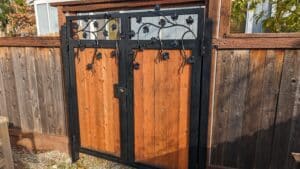In today’s competitive real estate market, homeowners are continually seeking effective ways to enhance the value of their properties. One key strategy lies in thoughtful home improvements, which not only elevate the living experience but also significantly boost property value. These enhancements, when chosen wisely, can yield a substantial Return on Investment (ROI), making them not just aesthetic upgrades but also smart financial decisions. Among the myriad of home improvement options, one often overlooked yet remarkably impactful choice is the addition of ironwork. Ironwork, encompassing elements like ornate gates, railings, and decorative accents, not only adds an element of timeless elegance to a property but also offers practical benefits such as increased security and durability. In this blog, we delve into the multifaceted ways in which ironwork can enhance the value of a home, exploring its unique blend of aesthetic appeal, functionality, and its potential to positively impact the ROI of home improvement projects.
Understanding the factors that influence home value is crucial for any homeowner looking to enhance their property’s market appeal.
A. Location: The geographic location of a property is often the most significant determinant of its value. Properties situated in desirable neighborhoods, with access to quality schools, amenities, and good transport links, generally fetch higher prices. The local community, safety records, and proximity to business centers or natural landscapes also play a vital role in determining a property’s worth.
B. Size and Layout: The size of the property, in terms of square footage, and its layout directly impact its market value. Larger homes with more bedrooms and bathrooms typically command higher prices. However, it’s not just about size; the layout’s functionality and flow are equally important. Open floor plans, spacious living areas, and smart use of space can significantly increase a property’s appeal and value.
C. Age and Condition: The age of a property and its current condition are also key factors in valuation. Newer homes often come with modern amenities and require less maintenance, making them more valuable. Conversely, older properties can also be valuable, especially if they are well-maintained or have historical significance. Regular upkeep, renovations, and repairs play a crucial role in preserving and enhancing a property’s value over time.
D. Aesthetic Appeal: The visual appeal of a property is a powerful factor in attracting potential buyers. This includes both the interior and exterior design elements. Curb appeal, which is the attractiveness of a property when viewed from the street, sets the first impression. Inside, well-coordinated interiors, quality finishes, and thoughtful designs contribute significantly to a property’s value. Aesthetic appeal is subjective, but universally, properties that create a strong, positive first impression tend to be valued higher.
The Role of Ironwork in Enhancing Property Value
Ironwork plays a multifaceted role in augmenting the value of a property. Its contribution goes beyond mere aesthetic appeal, offering durability, security, and a unique touch to any home.
A. Durability and Longevity: One of the most significant advantages of ironwork is its durability and longevity. Unlike other materials that may degrade or require frequent maintenance, ironwork stands the test of time, often with minimal upkeep. This enduring quality ensures that any home improvements made with ironwork are not just temporary enhancements but long-term investments, adding sustained value to a property.
B. Aesthetic Enhancement: The visual appeal of wrought iron cannot be overstated. Its ability to be molded into intricate designs offers a timeless elegance that enhances the aesthetic value of a property. From classic to contemporary, ironwork can be adapted to suit various architectural styles, ensuring that it complements and elevates the overall look of any home.
C. Security Enhancement: In addition to its beauty, ironwork significantly enhances the security of a property. Iron gates and fences act as robust barriers, deterring intruders and ensuring the safety of residents. This added security feature not only brings peace of mind to homeowners but also contributes to the overall value of the property, as secure homes are often more sought-after in the real estate market.
D. Customization and Versatility: Ironwork offers extensive customization options, catering to a wide range of tastes and preferences. Whether homeowners prefer simple, clean lines or intricate, ornate patterns, ironwork can be tailored to meet these desires. This versatility allows for unique designs that can make a property stand out in the market, potentially increasing its value.
Types of Ironwork Improvements
The application of ironwork in home improvements can take various forms, each contributing uniquely to the property’s value.
A. Gates and Fencing: Iron gates and fencing not only enhance the curb appeal of a property but also provide an added layer of security. They create a strong first impression, setting the tone for the rest of the property. Well-designed iron gates and fences can transform the look of a home, making it more appealing to potential buyers.
B. Railings and Balustrades: Adding iron railings to staircases and balconies serves a dual purpose. It improves the safety of these areas while also enhancing their aesthetic appeal. The elegance of iron balustrades can elevate the interior design of a home, adding a touch of sophistication that is both visually appealing and functional.
C. Decorative Accents: Ironwork is not limited to large-scale installations like gates or railings. Smaller decorative accents such as window grills, door embellishments, and iron light fixtures also play a significant role in enhancing a home’s beauty. These details can add character and charm to a property, making it more attractive to discerning buyers who appreciate attention to detail and craftsmanship.
Cost vs. Value Analysis
When considering ironwork as a home improvement option, it’s essential to evaluate the financial aspects, including the investment costs and the potential return on investment (ROI).
A. Investment Costs: The costs involved in ironwork installation can vary widely depending on several factors. These include the complexity of the designs, the extent of the work (whether it’s a small decorative element or a large installation like gates or fencing), and the quality of materials used. Custom designs and intricate patterns typically cost more due to the higher level of craftsmanship required. Additionally, the installation costs can vary based on the property’s specifics and the need for any preparatory work. Homeowners should get detailed quotes from several vendors to understand the cost implications better.
B. ROI Expectations: The ROI of ironwork improvements can be quite significant. While the initial cost may be higher than some other home improvements, the long-term benefits often justify the investment. The durability of ironwork means less expenditure on maintenance and replacements over time. Moreover, the added aesthetic appeal and security can substantially increase a property’s market value. When selling a home, these features can be major selling points, potentially leading to a higher sale price.
C. Comparing Ironwork ROI with Other Home Improvements: When compared to other home improvement projects, ironwork can offer a competitive ROI. While kitchen and bathroom remodels are often cited for high returns, they can also be costly and subject to personal tastes. Ironwork, on the other hand, offers a more universally appealing improvement. Its contribution to curb appeal, security, and overall property aesthetics positions it as a valuable addition. However, it’s important for homeowners to consider their specific market and how such improvements are valued in their particular area. Consulting with a real estate professional can provide insights into how ironwork improvements might compare with other renovations in terms of ROI in their local real estate market.
Case Studies
A. Real-life Examples: To illustrate the impact of ironwork on property value, consider the case of a mid-century home in a well-established neighborhood. Originally, the property lacked defining features and had a relatively plain exterior. After the addition of custom-designed iron gates and window grills, the property not only stood out in terms of curb appeal but also saw a significant increase in its market valuation. Similarly, a historic home received a value boost after restoring its original ironwork features, highlighting how ironwork can enhance both modern and traditional properties.
B. Testimonials: Homeowners who invested in ironwork often express satisfaction not just with the aesthetic improvement but also with the value it adds to their property. Real estate professionals echo these sentiments, noting that properties with high-quality ironwork tend to attract more interest and can command higher prices. They point out that ironwork is frequently a key factor in closing sales, particularly in competitive markets where distinctive features set properties apart.
Additional Resources
- Architectural Iron Designs, Inc. – Offers a range of ornamental ironwork components including grande forge collections, iron railings, posts, and balusters. Visit Architectural Iron Designs.
- Indital USA – Specializes in wrought iron balusters, railings, and panels with access to over 30,000 components. Visit Indital USA.
- Steel Supply, L.P. – Provides online sales of ornamental iron, including decorative and hardware elements for fences, gates, railings, and more. Visit Steel Supply L.P..
These resources can provide a wealth of information and inspiration for those considering ironwork for their property.



